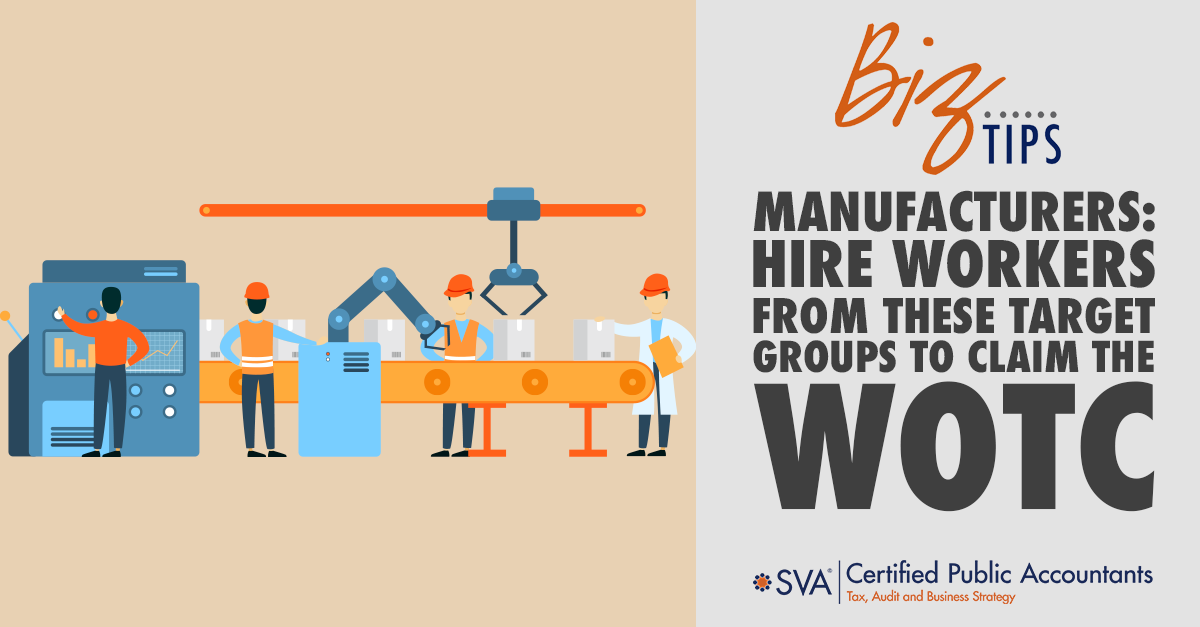If your manufacturing company is like many others in the industry, you’re having difficulty finding top-notch new hires to expand your workforce as well as to replace employees who are retiring or quitting. At the same time, you’d like to reduce your tax liability for 2022.
Practical solution: Kill two birds with one stone by hiring workers from certain “target” groups. This move can help close the skilled labor gap, and you may qualify for a tax credit — the Work Opportunity Tax Credit (WOTC) — at the same time. What’s more, if your company employs certain teenagers during the next few months, it may be in line for a special “summertime” version of the WOTC.
WOTC Rules and the Target Groups
The WOTC is designed to encourage employers (such as manufacturers) to hire workers from several disadvantaged groups.
Generally, the credit equals 40% of a worker’s first-year wages of up to $6,000, for a maximum credit of $2,400 per qualified worker. However, the WOTC may be larger in certain situations. For instance, it may be claimed for the first $24,000 of wages paid to certain disabled veterans, for a maximum credit of $9,600 per qualified worker.
There’s no limit on the number of credits a manufacturer can claim. For example, let’s say you hire 10 eligible workers to ramp up operations this year. As a result, you may be able to claim a total credit of $24,000 if each eligible employee is paid at least $6,000 in wages in 2022.
Each employee must complete at least 120 hours of service. The credit isn’t available for certain employees who are related to the employer or work more than 50% of the time outside of the business (such as a maid working in the employer’s home). In addition, the credit generally can’t be claimed for employees who’ve previously worked for the employer.
The WOTC has expired and been reinstated multiple times in the past, mostly for only a year or two. But in 2021, it was extended for five years, through 2025.
The list of target groups eligible for the WOTC has remained relatively stable in recent years with just a couple of tweaks. Currently, it covers the following groups:
- Qualified IV-A Temporary Assistance for Needy Families Recipients
- Qualified Veterans (including disabled veterans)
- Ex-Felons
- Designated Community Residents
- Vocational Rehabilitation Referrals
- Supplemental Nutrition Assistance Program Recipients
- Supplemental Security Income Recipients
- Long-Term Family Assistance Recipients
- Qualified Long-Term Unemployment Recipients
Calculating the Credit
A manufacturer can count $6,000 of first-year wages per employee beginning from the employee’s start date. This amount increases to $10,000 for long-term family assistance recipients and $12,000, $14,000, or $24,000 for certain veterans. If the employee completed at least 120 hours but less than 400 hours of service, the wages are multiplied by 25%. If the employee completed 400 or more hours, all the wages are multiplied by 40%.
Thus, as previously noted, the maximum credit available for first-year wages generally is $2,400, but it can be as high as $9,600 for certain veterans. In addition, for long-term family assistance recipients, a 50% credit may be available for up to $10,000 of second-year wages, resulting in a total maximum credit over two years of $9,000 per qualified worker ($10,000 × 40% plus $10,000 × 50%).
(Download Video Transcript)
3 Key Limits
Be aware that three key limits apply to employers claiming the WOTC:
- No income tax deduction is allowed for the portion of wages equal to the amount of the credit determined for the tax year.
- Other employment-related credits generally are reduced with respect to an employee for whom a WOTC credit is allowed.
- The credit is subject to the overall limitations on the amount of business credits that can be taken in any tax year. (However, a one-year carryback and 20-year carryforward of unused business credits is allowed.)
Because of these limits, there may be times when a manufacturer might elect not to have the WOTC apply. Also, other rules may prohibit the credit or require an allocation of the credit under certain circumstances.
Basking in a Summertime WOTC
There’s still time to take advantage of a special version of the WOTC for hiring certain disadvantaged youths during the summer months. The summertime WOTC is available if you employ individuals who are age 16 or 17 and reside in an empowerment zone, enterprise community, or renewal community.
Under this version of the WOTC, only wages paid for services performed between May 1st and September 15th can be counted. The credit amount generally equals 25% of a worker’s qualified first-year wages up to $3,000, for a maximum credit of $750 per worker.
However, the summertime credit increases to 40% of a worker’s first-year wages up to $3,000 if the youth works 400 hours or more. In this case, the maximum credit per qualified worker is $1,200. Be aware that if your company employed the youth prior to this summer, you can’t claim the credit for that worker.
Contact Us for Details
It’s important to be aware that your manufacturing company must comply with a complex certification process before it can claim a WOTC. We can help you coordinate these activities as well as answer any questions.

© 2022

